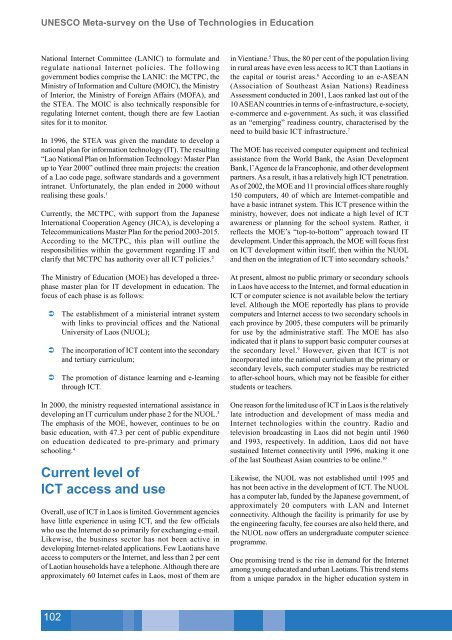Download (PDF, 2.MB) - UNESCO Bangkok
Download (PDF, 2.MB) - UNESCO Bangkok
Download (PDF, 2.MB) - UNESCO Bangkok
- No tags were found...
Create successful ePaper yourself
Turn your PDF publications into a flip-book with our unique Google optimized e-Paper software.
<strong>UNESCO</strong> Meta-survey on the Use of Technologies in EducationNational Internet Committee (LANIC) to formulate andregulate national Internet policies. The followinggovernment bodies comprise the LANIC: the MCTPC, theMinistry of Information and Culture (MOIC), the Ministryof Interior, the Ministry of Foreign Affairs (MOFA), andthe STEA. The MOIC is also technically responsible forregulating Internet content, though there are few Laotiansites for it to monitor.In 1996, the STEA was given the mandate to develop anational plan for information technology (IT). The resulting“Lao National Plan on Information Technology: Master Planup to Year 2000” outlined three main projects: the creationof a Lao code page, software standards and a governmentintranet. Unfortunately, the plan ended in 2000 withoutrealising these goals. 1Currently, the MCTPC, with support from the JapaneseInternational Cooperation Agency (JICA), is developing aTelecommunications Master Plan for the period 2003-2015.According to the MCTPC, this plan will outline theresponsibilities within the government regarding IT andclarify that MCTPC has authority over all ICT policies. 2The Ministry of Education (MOE) has developed a threephasemaster plan for IT development in education. Thefocus of each phase is as follows:The establishment of a ministerial intranet systemwith links to provincial offices and the NationalUniversity of Laos (NUOL);The incorporation of ICT content into the secondaryand tertiary curriculum;The promotion of distance learning and e-learningthrough ICT.In 2000, the ministry requested international assistance indeveloping an IT curriculum under phase 2 for the NUOL. 3The emphasis of the MOE, however, continues to be onbasic education, with 47.3 per cent of public expenditureon education dedicated to pre-primary and primaryschooling. 4Current level ofICT access and useOverall, use of ICT in Laos is limited. Government agencieshave little experience in using ICT, and the few officialswho use the Internet do so primarily for exchanging e-mail.Likewise, the business sector has not been active indeveloping Internet-related applications. Few Laotians haveaccess to computers or the Internet, and less than 2 per centof Laotian households have a telephone. Although there areapproximately 60 Internet cafes in Laos, most of them arein Vientiane. 5 Thus, the 80 per cent of the population livingin rural areas have even less access to ICT than Laotians inthe capital or tourist areas. 6 According to an e-ASEAN(Association of Southeast Asian Nations) ReadinessAssessment conducted in 2001, Laos ranked last out of the10 ASEAN countries in terms of e-infrastructure, e-society,e-commerce and e-government. As such, it was classifiedas an “emerging” readiness country, characterised by theneed to build basic ICT infrastructure. 7The MOE has received computer equipment and technicalassistance from the World Bank, the Asian DevelopmentBank, l’Agence de la Francophonie, and other developmentpartners. As a result, it has a relatively high ICT penetration.As of 2002, the MOE and 11 provincial offices share roughly150 computers, 40 of which are Internet-compatible andhave a basic intranet system. This ICT presence within theministry, however, does not indicate a high level of ICTawareness or planning for the school system. Rather, itreflects the MOE’s “top-to-bottom” approach toward ITdevelopment. Under this approach, the MOE will focus firston ICT development within itself, then within the NUOLand then on the integration of ICT into secondary schools. 8At present, almost no public primary or secondary schoolsin Laos have access to the Internet, and formal education inICT or computer science is not available below the tertiarylevel. Although the MOE reportedly has plans to providecomputers and Internet access to two secondary schools ineach province by 2005, these computers will be primarilyfor use by the administrative staff. The MOE has alsoindicated that it plans to support basic computer courses atthe secondary level. 9 However, given that ICT is notincorporated into the national curriculum at the primary orsecondary levels, such computer studies may be restrictedto after-school hours, which may not be feasible for eitherstudents or teachers.One reason for the limited use of ICT in Laos is the relativelylate introduction and development of mass media andInternet technologies within the country. Radio andtelevision broadcasting in Laos did not begin until 1960and 1993, respectively. In addition, Laos did not havesustained Internet connectivity until 1996, making it oneof the last Southeast Asian countries to be online. 10Likewise, the NUOL was not established until 1995 andhas not been active in the development of ICT. The NUOLhas a computer lab, funded by the Japanese government, ofapproximately 20 computers with LAN and Internetconnectivity. Although the facility is primarily for use bythe engineering faculty, fee courses are also held there, andthe NUOL now offers an undergraduate computer scienceprogramme.One promising trend is the rise in demand for the Internetamong young educated and urban Laotians. This trend stemsfrom a unique paradox in the higher education system in102
















